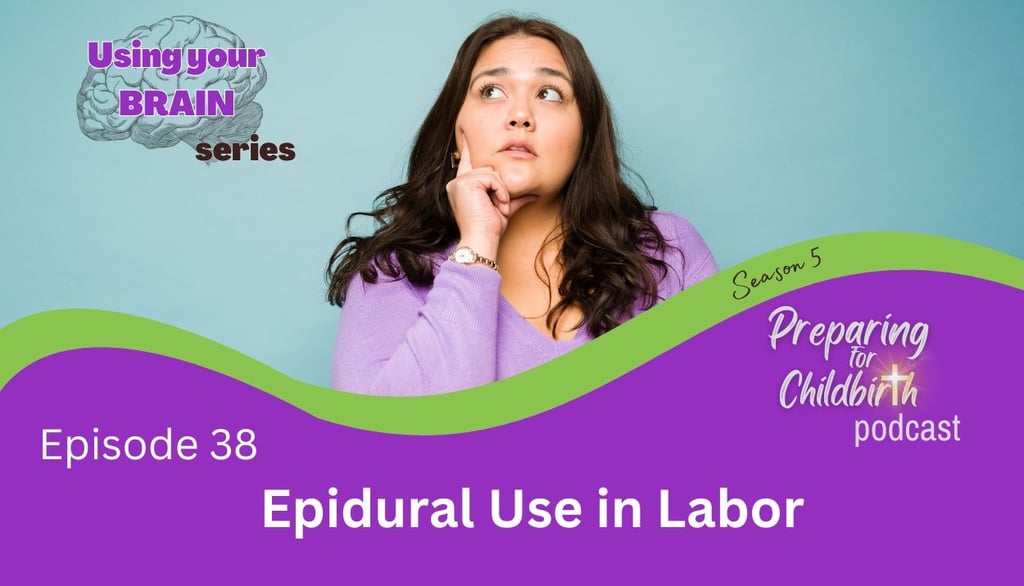38- Epidural Use in Labor
Use Your BRAIN series. In this episode we discuss the Benefits, Risks, and Alternatives to epidural use to help you make an informed decision about whether this intervention is right for you.
Jenny Childs
6/26/20257 min read


Transcript:
This is episode 38. Today we’re continuing our series on informed decision making and we’ll be talking about use of an Epidural. This particular intervention is more popular in some parts of the world than others. An epidural is an injection of a numbing medication into the space around your spinal nerves to provide pain relief. This is done by inserting a needle and catheter into the lower part of a woman’s back during labor. The catheter tube remains in place so that the medication can be administered as needed. A traditional epidural completely immobilizes you and you will need to stay in bed because of decreased sensation in your legs, though you should still be able to move your legs some in bed with help. A low dose epidural can allow for some measure of mobility with support. Sometimes a low dose epidural is referred to as a walking epidural but even so, you should know that your mobility is likely to be somewhat limited.
Epidural use is very common in the US. For many women, it’s just a given that she will get an epidural when she goes into labor. I want to encourage you here to pause for a minute and actually make an informed decision about whether or not an epidural is right for you and when it might be beneficial or not. It’s fine to choose to have an epidural but I encourage you not to do it out of fear or just because that’s what everybody does.
So, let’s use our BRAIN to think about how to make an informed decision when it comes to epidurals. If you’re not familiar with the BRAIN acronym, I encourage you to go back and listen to episode 31 to learn more about that. I’ll put a link in the show notes.
Ok. The first letter in our acronym is B. What are the Benefits of using an epidural during labor? There are a few significant benefits. It does not alter the mama’s consciousness like some other forms of pain relief – which is a very good thing. And it provides pretty much a total block of all sensations below the site. (Some people see that as a benefit and others do not.) If mama needs some sleep, this could be particularly beneficial. It can also help lower blood pressure of a pregnancy-induced hypertension patient.
Now R. What risks are associated with an epidural during labor? Depending on whether you get a traditional epidural or a low dose epidural, you will be completely confined to bed or have limited mobility. With the low dose epidural you may still be able to walk some. Because of your decreased mobility and lack of sensation, especially with a traditional epidural, mama now has a less active role in the baby’s birth.
Both the traditional and the low-dose epidural come with the risk of side effects, some of which include low blood pressure, itchy skin, and headaches.
Epidurals can be expensive and are not covered by insurance in some parts of the world.
Whether low-dose or traditional, an epidural usually makes the second stage of labor, that is the pushing stage, longer. With a traditional epidural it is more difficult to push effectively which increases the risk of needing vacuum or forceps assistance. This is less of a problem with a low-dose epidural because mama is able to have a bit more sensation to help her work with the contractions and she can still move around with assistance and can make use of more upright pushing positions to allow gravity to help out as well.
An epidural requires continuous electronic fetal monitoring, an IV, blood pressure cuff, and catheter. Like I’ve already mentioned there is a risk of decreased blood pressure for mama but this may also affect the baby’s oxygen supply and affect his/her heart rate. There is a risk of the epidural slowing down labor – which in some cases might be called for but in others not desired. There is also a possibility of the epidural causing a low grade fever. If you water’s already broken, the fever will have to be assumed to be caused by infection rather than the epidural. Most care providers err on the side of caution with this causing the baby to have to have a “septic work-up” for infection after birth even though he/she is not infected. Some other risks for baby include a higher rate of abnormal fetal heart tones and higher rates of babies being born with low Apgar scores. When an epidural is used there are also higher rates of babies being born with trouble breathing, poor muscle tone and difficulty with breastfeeding.
Whew. That’s a lot of risks but you have to decide for yourself to what extent you consider each of the things I’ve mentioned as a risk or not. And then thinking about your particular situation decide if the risks associated with having an epidural outweigh the benefits or vice versa.
Another thing to take into consideration as you are making an informed decision is the A in our acronym – Alternatives. What alternatives are available to you to help you manage the pain?
First of all, if it’s possible to avoid the use of Pitocin (that is, a synthetic form of oxytocin) then the contractions are likely to be more manageable. I talk about benefits and risks of Pitocin use in episode 34 & 4.
People say that a bath is like a natural epidural. So laboring in a birthing pool or in the bathtub or a shower can really help with relaxation and pain relief.
Breathing and other relaxation techniques, as well as massage and counter pressure can also be super helpful. Being able to move around and try different positions often works not only to help move labor along but also to help manage the pain. I highly recommend a good childbirth education class to help you learn more comfort measures and coping techniques to use in labor – especially if you decide you want to avoid using an epidural. However, even if you decide an epidural is the way you want to go, I would still recommend a good childbirth class. You learn so much more in the class than just the comfort measures but chances are you’re going to need those techniques at some point, even if your plan is to use an epidural.
In my Growing in Confidence and Peace childbirth course we cover comfort measures and coping techniques in module 2 and I provide short videos to help you know how to try out and practice many of them. I’ll put a link in the show notes, if you’d like more information about that course.
In addition, having a doula – if that’s a possibility - can also be beneficial to help you know how to navigate the pain, find ways to cope with it, and remember what you’ve learned.
Ok. So far we’ve discussed Benefits, Risks and Alternatives. The next letter in the BRAIN acronym is I. It stands for Intuition & I always encourage that to be prayer informed. Spend some time praying & asking for the Lord’s guidance in your particular situation. Think about your circumstances and your preferences. Think about how getting an epidural might line up with your preferences or how it might lead away from them. Talk with your husband or another support person, then make your decision.
And the last letter. N. Now or Never? This is a reminder that timing is a consideration, too. If you decide that you’d like to try to go as far as you can without an epidural, let me share some information that a mama told me recently that she wished she’d known ahead of time. Here it is… most of the time when a mama gets to the point where she feels like she cannot handle any more, it is an excellent indicator that she’s almost ready to push and so close to meeting her baby. This particular mama said she wished she’d just waited 30 minutes. Her baby was born pretty quickly after she got the epidural and then she had to deal with all the aftereffects of the epidural. She felt like she could have held out for 30 more minutes if she’d realized how close she was. Of course, you don’t know for sure, but it’s often the case that mama feeling like she can’t go any further is a good signpost that the end is near. I always encourage daddies to remember this and remind mama of how close she is and to encourage her how great she’s done so far.
Another thing to think about and talk about with your spouse or any other support person you plan to have with you … if you decide to try to avoid using an epidural or any other pharmacological pain med. Think about how you deal with stressful situations. If you like to vent out loud and complain and want to be free to do that without anyone trying to “” fix the situation. I suggest you come up with a code word and unless you use your code word, your husband or other support person will not suggest an epidural. This allows you to say things like, “This is so hard” “I don’t know if I can do this” and they will know to respond with encouragement that you can do this and maybe remind you of one of the coping techniques you learned together ahead of time, rather than suggesting an epidural or other pain meds right off.
One last thing, before we leave this topic… epidural use can sometimes be a divisive topic. What I want to encourage here is informed decision making, meaning you take the time to get the information needed to make the best decision you can in your particular situation – and your personality and preferences can play a role in that. It’s important for you to seek to make your decisions from a place of wisdom and not fear. I talk about that more in episode 31 which you can go back and listen to if you haven’t already.
Show notes:
Using Your BRAIN series. In this episode we discuss the Benefits, Risks, and Alternatives to epidural use to help you make an informed decision about whether this intervention is right for you.
Resources Mentioned:
Episode 31 – Informed Decision Making & God’s Word
Episode 34 – Synthetic Oxytocin/Pitocin
Episode 4 – Thinking About Labor Induction
Connect with me:
Growing in Confidence & Peace Childbirth Course
If you’re local to Nairobi, Kenya, this is the link for you!
© Preparing for Childbirth 2025.
All rights reserved.
Disclaimer: Content and information on this website and related social media are for informational and educational purposes only and are not intended to be a substitute for professional medical advice, diagnosis, or treatment. Users are advised to consult their physician or midwife when making decisions about care.
